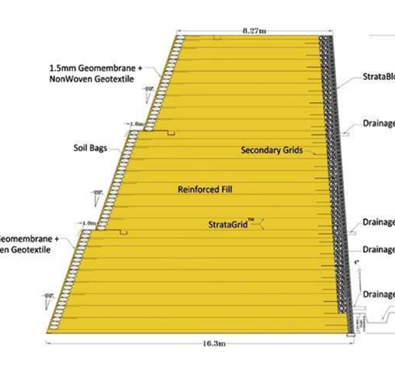Functions of geosynthetics
Geotextiles, geomembranes, geocells, geonets, geotubes, uniaxial geogrids, biaxial geogrids, geocomposites, and many more are all types of geosynthetic materials that play a pivotal role in modern engineering and environmental management. These innovative materials are manufactured from synthetic polymers and are designed to enhance the performance and durability of civil engineering projects. Geosynthetics are versatile and can be tailored to meet specific project requirements, making them suitable for a wide range of applications. For instance, geotextiles are commonly used in road construction for separation and filtration, while geomembranes serve as effective barriers in waste containment systems. Geocells provide structural support by confining soil, whereas geonets facilitate drainage in various applications. The adaptability of these materials allows them to be employed in projects ranging from grassroots community initiatives to mega infrastructure developments. Their importance cannot be overstated, and let’s discuss the functions of geosynthetics in detail to understand their impact further.
What are the functional requirements of geosynthetics?
Geosynthetics are used in construction and environmental projects for different purposes such as enhancing durability, managing fluids, or stabilizing terrains. They can perform separation, filtration, reinforcement, and protection among other roles.

- Separation: In building, it is necessary to have something that will not let different soil layers mix, as well as make sure that road bases and foundations are solid. Geotextiles work best for this purpose; they also help to prevent decorative landscaping from being ruined by keeping gravel from sinking into the subsoil. This saves on resources and extends both construction materials and landscape designs lifespans too.
- Filtration: The filtration function involves allowing water to pass through the geosynthetic while retaining soil particles. In drainage systems, geotextiles prevent fine soil from clogging the drain. In slope stabilization, this function is critical for preventing the buildup of pore water pressure—a primary cause of slope failure—by allowing groundwater to escape while holding the soil in place.
- Drainage: Geosynthetics help regulate water flow during construction or landscaping projects. They are used underground for subsurface drainage to avoid water logging and damage foundation. They play a significant role in large infrastructures such as highways where they aid in preventing accumulation of rainwater leading up to pavement failure. In addition, urban stormwater management often uses these materials which can reduce risks associated with flooding while improving city supplies cleanliness.
- Protection: The protection function involves using a geosynthetic, typically a thick nonwoven geotextile, to cushion a material from damage. In landfill lining systems, a geotextile protects the impermeable geomembrane from being punctured by sharp rocks or waste. Similarly, a geotextile can be wrapped around a pipeline to protect its coating from damage during backfilling.
- Reinforcement: The use of geosynthetics improves the load-bearing capacity (LBC) of soils used for road construction or pavement rehabilitation through even distribution of loads over wider areas thus minimizing localized failures within such layers caused by excessive concentrations of stresses applied onto them alone. They prevent deformations along roadsides created due to differential settlements emanating from soft spots beneath pavement bases or subgrade soils that would have otherwise led to premature failure modes like rutting and among others commonly associated with flexible pavements constructed on weak foundations especially when subjected to heavy traffic loading during their service lives.
- Erosion control: Geosynthetics are very useful for erosion control caused by water and wind from damaging the soil. This is achieved by stabilizing slopes and embankments, especially in areas with heavy rainfall or prone to flooding. For instance, geotextiles anchor soil particles in place while allowing water to drain through them thus preventing washouts. They are also critical for shoreline protection projects where they dissipate the energy from waves and currents, preventing the erosion of riverbanks and coastlines to protect both property and natural habitats.
- Barriers: In environmental protection, geosynthetics (specifically geomembranes and geosynthetic clay liners) serve as impermeable barriers to contain liquids and gases within a specified area, such as a landfill, preventing the contamination of the surrounding soil and groundwater.They are used as liners and caps for landfills that contain leachates and gases thereby preventing contamination of surrounding soils and water bodies. These materials also hinder water from soaking into the ground around foundations, hence preserving their strength while at the same time reducing ecological imbalances through moisture loss.
- Stress Relief: In pavement engineering, the stress relief function is performed by a paving fabric (a specialized geotextile) which is saturated with asphalt and placed as an interlayer between a cracked existing pavement and a new asphalt overlay; this system absorbs stress and prevents the underlying cracks from propagating up into the new surface, a failure known as reflective cracking
